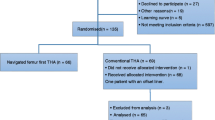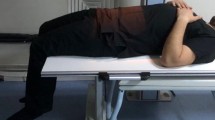Abstract
The criteria for acetabular cup positioning during total hip replacement are a matter of considerable discussion, particularly with regards to the optimal degree of anteversion. “Anatomical anteversion” is defined in the transverse plane, and “surgical anteversion” in the sagittal plane. Computed tomography measurements of anteversion are characteristic of a given transverse section plane and fail to take into account the position of the pelvis. We suggest a simple method for evaluating acetabular cup position in both the transverse and sagittal planes during standing and sitting. By shedding new light on the relationships between the pelvis and the spine, this method may help to understand some cases of impingement, instability or abnormal wear.








Similar content being viewed by others
References
Ackland MK, Bourne WB, Uhthoff HK (1986) Anteversion of the acetabular cup. Measurement of angle after total hip replacement. J Bone Joint Surg 68B: 409–413
Ala Eddine T, Migaud H, Chantelot C, Cotten A, Fontaine C, Duquennoy A (2001) Variations of pelvic anteversion in the lying and standing positions: analysis of 24 control subjects and implications for CT measurement of position of a prosthetic cup. Surg Radiol Anat 23: 105–102
Anda S, Svenningsen S, Grontvedt T, Benum P (1990) Pelvic inclination and spatial orientation of the acetabulum. A radiographic, computed tomographic and clinical investigation. Acta Radiol 31: 389–394
Boulay C (1998) Morphométrie comparative anatomo-radiologique du bassin ou vertèbre pelvienne: application clinique. Rachis 10: 207–208
Chandler DR, Glousman R, Hull D, McGuire PJ, Kim IS, Clarke IC, Sarmiento A (1982) Prosthetic hip range of motion and impingement. The effects of head and neck geometry. Clin Orthop 166: 284–291
Charnley J (1979) Low friction arthroplasty of the hip. Springer, Berlin, p 246
Eliasziw M, Young SL, Woodbury MG, Fryday-Field K (1994) Statistical methodology for the concurrent assessment of interrater and intrarater reliability: using goniometric measurements as an example. Phys Ther 74: 777–788
Harris WH (ed) (1985) The precoat total hip replacement system: surgical technique. In: Advanced concepts in total hip replacement. Thorofare, Slack, p 117
Hassan DM, Johnston GH, Dust WN, Watson LG, Cassidy D (1995) Radiographic calculation of anteversion in acetabular prostheses. J Arthroplasty 10: 369–372
Herrlin K, Selvik G, Petterson H (1986) Space orientation of total hip prosthesis. A method for three-dimensional determination. Acta Radiol 27: 619–627
Herrlin K, Selvik G, Petterson H, Hesek P, Onnerfalt R, Ohlin A (1988) Position, orientation and component interaction in dislocation of the total hip prosthesis. Acta Radiol 29: 441–444
Hedlundh U, Hybbinette CH, Fredin H (1995) Influence of surgical approach on dislocations after Charnley hip arthroplasty. J Arthroplasty 10: 609–614
Hedlundh U, Ahnfelt L, Hybbinette CH, Wallinder L, Weckstrom J, Fredin H (1996) Dislocations and the femoral head size in primary total hip arthroplasty. Clin Orthop 333: 226–233
Kennedy JG, Rogers WB, Soofe KE, Sullivan RJ, Griffen DG, Sheehan LJ (1998) Effect of acetabular component orientation on recurrent dislocation, pelvic osteolysis, polyethylene wear and component migration. J Arthroplasty 13: 530–534
Krushell RJ, Burke DW, Harris WH (1991) Range of motion in contemporary total hip arthroplasty. The impact of modular head-neck components. J Arthroplasty 6: 97–101
Kummer FJ, Shah S, Iyer S, DiCesare PE (1999) The effect of acetabular cup orientations on limiting hip rotation. J Arthroplasty 14: 509–513
Lazennec JY, Ramaré S, Arafati N et al. (2000) Sagittal alignment in lumbosacral fusion: relations between radiological parameters and pain. Eur Spine J 9: 47–55
Lewinnek GE, Lewis JL, Tarr R, Compere CL, Zimmerman JR (1978) Dislocations after total hip-replacement arthroplasties. J Bone Joint Surg 60A: 217–220
Maruyama M, Feinberg JR, Capello WN, D’Antonio JA (2001) The Frank Stinchfield Award. Morphologic features of the acetabulum and femur: anteversion angle and implant positioning. Clin Orthop 393: 52–65
McKibbin B (1991) Anatomical factors in the stability of the hip joint in the newborn. J Joint Bone Surg 52B: 148
Messieh M, Mattingly DA, Turner RH, Scott R, Fox J, Slater J (1994) Wear debris from bipolar femoral neck-cup impingement. A cause of femoral stem loosening. J Arthroplasty 9: 89–93
Mian SW, Truchly G, Pflum FA (1993) Computed tomography measurement of acetabular cup anteversion and retroversion in total hip arthroplasty. Clin Orthop 276: 206–209
Müller ME (1983) Total hip reconstruction. In: Evarts CM (ed) Surgery of the musculoskeletal system. Churchill Livingstone, New York, p 238
Murray DW (1992) The definition and measurement of acetabular orientation. J Bone Joint Surg 75B: 228–232
Robinson RP, Simonian PT, Gradisar IM, Ching RP (1997) Joint motion and surface contact area related to component position in total hip arthroplasty. J Bone Joint Surg 79B: 140–146
Seifert CF, Brown TD, Pedersen DR, Callaghan JJ (1998) A finite element analysis of factors influencing total hip dislocation. Clin Orthop 355: 152–162
Seki M, Yuasa N, Ohkuni K (1998) Analysis of optimal range of socket orientations in total hip arthroplasty with use of computer-aided design simulation. J Orthop Res 16: 513–517
Seradge H, Nagle KR, Miller RJ (1982) Analysis of version in the acetabular cup. Clin Orthop 166: 152–157
Terver S, Dillingham M, Parker B et al. (1982) True orientation of the acetabulum as determined by CAT scan. Preliminary results. J Radiol 63: 167–173
Yamaguchi M, Bauer TW, Hashimoto Y (1997) Three-dimensional analysis of multiple wear vectors in retrieved acetabular cups. J Bone Joint Surg 79A: 1539–1544
Author information
Authors and Affiliations
Corresponding author
Rights and permissions
About this article
Cite this article
Lazennec, JY., Charlot, N., Gorin, M. et al. Hip-spine relationship: a radio-anatomical study for optimization in acetabular cup positioning. Surg Radiol Anat 26, 136–144 (2004). https://doi.org/10.1007/s00276-003-0195-x
Received:
Accepted:
Published:
Issue Date:
DOI: https://doi.org/10.1007/s00276-003-0195-x




